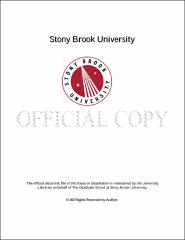| dc.identifier.uri | http://hdl.handle.net/11401/76306 | |
| dc.description.sponsorship | This work is sponsored by the Stony Brook University Graduate School in compliance with the requirements for completion of degree. | en_US |
| dc.format | Monograph | |
| dc.format.medium | Electronic Resource | en_US |
| dc.language.iso | en_US | |
| dc.publisher | The Graduate School, Stony Brook University: Stony Brook, NY. | |
| dc.type | Thesis | |
| dcterms.abstract | The threat of oil pollution increases with the expansion of oil exploration and production activities, as well as the industrial growth around the world. Use of sorbents is a common method to deal with the oil spills. In this work, an advanced sorbent technology is described. A series of non-woven Cellulose Acetate (CA) nanofibrous mats with a 3D fibrous structure were synthesized by a novel high-throughput electrospinning technique. The precursor was solutions of CA/ acetic acid-acetone in various concentrations. Among them, 15.0% CA exhibits a superhydrophobic surface property, with a water contact angle of 128.95°. Its oil sorption capacity is many times higher the oil sorption capacity of the best commercial sorbent available in the market. Also, it showed good buoyancy properties on the water both as dry-mat and oil-saturated mat. In addition, it is biodegradable, easily available, easily manufactured, so the CA nanofibrous mat is an excellent candidate as oil sorbent for oil spill in water treatment. | |
| dcterms.abstract | The threat of oil pollution increases with the expansion of oil exploration and production activities, as well as the industrial growth around the world. Use of sorbents is a common method to deal with the oil spills. In this work, an advanced sorbent technology is described. A series of non-woven Cellulose Acetate (CA) nanofibrous mats with a 3D fibrous structure were synthesized by a novel high-throughput electrospinning technique. The precursor was solutions of CA/ acetic acid-acetone in various concentrations. Among them, 15.0% CA exhibits a superhydrophobic surface property, with a water contact angle of 128.95°. Its oil sorption capacity is many times higher the oil sorption capacity of the best commercial sorbent available in the market. Also, it showed good buoyancy properties on the water both as dry-mat and oil-saturated mat. In addition, it is biodegradable, easily available, easily manufactured, so the CA nanofibrous mat is an excellent candidate as oil sorbent for oil spill in water treatment. | |
| dcterms.available | 2017-09-20T16:50:00Z | |
| dcterms.contributor | Gersappe, Dilip | en_US |
| dcterms.contributor | Gouma, Pelagia-Irene | en_US |
| dcterms.contributor | Sokolov, Jonathan. | en_US |
| dcterms.creator | Han, Chao | |
| dcterms.dateAccepted | 2017-09-20T16:50:00Z | |
| dcterms.dateSubmitted | 2017-09-20T16:50:00Z | |
| dcterms.description | Department of Materials Science and Engineering. | en_US |
| dcterms.extent | 59 pg. | en_US |
| dcterms.format | Application/PDF | en_US |
| dcterms.format | Monograph | |
| dcterms.identifier | http://hdl.handle.net/11401/76306 | |
| dcterms.issued | 2015-12-01 | |
| dcterms.language | en_US | |
| dcterms.provenance | Made available in DSpace on 2017-09-20T16:50:00Z (GMT). No. of bitstreams: 1
Han_grad.sunysb_0771M_12349.pdf: 2454930 bytes, checksum: 616c03e1d201914c050a48ac2efcdd7e (MD5)
Previous issue date: 1 | en |
| dcterms.publisher | The Graduate School, Stony Brook University: Stony Brook, NY. | |
| dcterms.subject | Cellulose Acetate, High-Throughput, Nanofibrous, Sorbent | |
| dcterms.subject | Materials Science | |
| dcterms.title | Super-Hydrophobic High Throughput Electrospun Cellulose Acetate (CA) Nanofibrous Mats as Oil Selective Sorbents | |
| dcterms.type | Thesis | |

